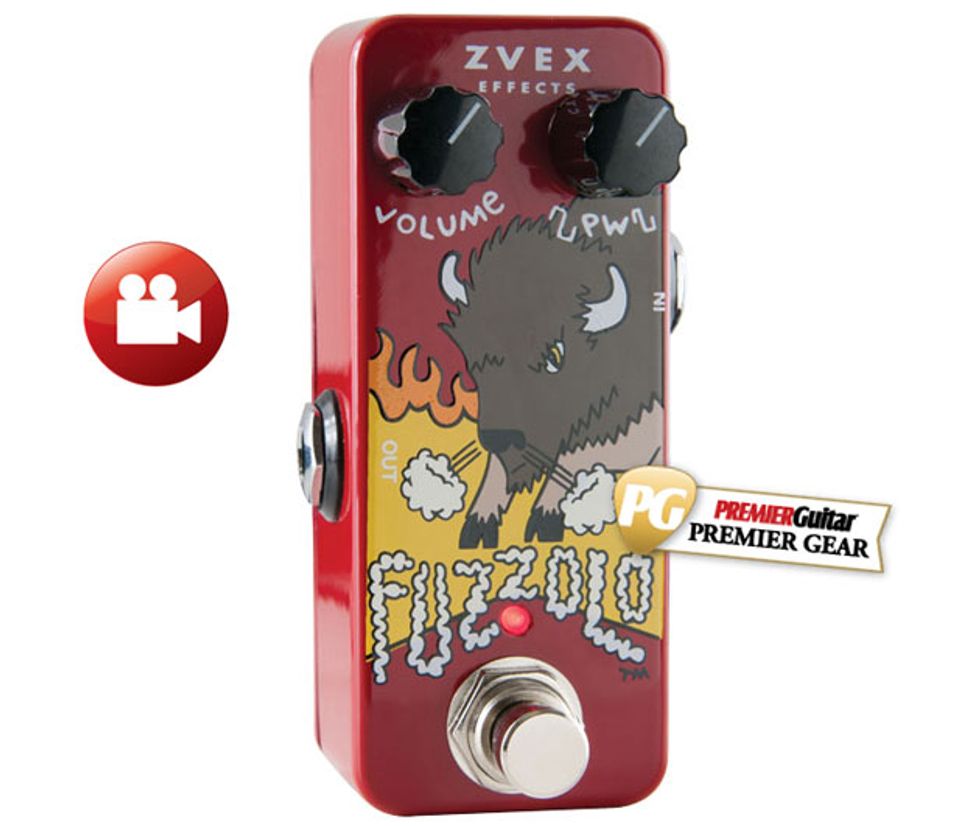ZVEX didn’t make its good name by taking the path most travelled. The same sense of irreverence that’s driven the company from day one guides nearly every creation that emerges from its Minnesota shop. And even as the company enters the raging micro-pedal arms race, where size limitations sometimes demand conservative design, ZVEX shows no signs of surrendering its adventurous spirit.
Take the diminutive Fuzzolo reviewed here. It’s a silicon fuzz that sounds way bigger than it looks, but it also has a blendable pulse width control (borrowed from ZVEX’s Mastotron) that’s a simple, surprisingly versatile, and sometimes radical tool for tweaking the rich fuzz output. The sounds you can get with this 2-knob baby monster are both massive and wonderfully mangled—the kind of stuff likely to stoke heavy riffing thugs and lo-fi sonic sculptors alike.
A Little Rolling Thunder
The Fuzzolo’s microscopic size did not deter ZVEX from indulging their customary flair for the visual. And though the pedal isn’t even 1.5" wide and barely 3.5" long, ZVEX still managed to cram a raging, snorting buffalo, and the flames of some fuzz-driven prairie fire onto a fire engine red enclosure that shows up bold and bright on an overflowing pedalboard. There’s a knob for volume level. But the second knob, which on most 2-knob fuzzes would be a gain control, is a pulse width control that changes the waveform from a square wave to a wave with narrow peaks and wide valleys. The fractured sounds from this control are the key the Fuzzolo’s brutish-to-curious sonic range.
Lest you think that small size means less horsepower, let us say right out of the gate that the Fuzzolo is loud. Unity gain is somewhere just left of the noon setting on the volume knob, and the pedal gets significantly bigger and badder beyond that.
At the full square-wave setting, which is essentially the “purest” version of the fuzz, the Fuzzolo has a complex, deep, and brawny voice—present and growling in the low-mid zone with a trace of octave-up content. The sum is the kind of sassy but muscular tone that silicon Fuzz Face and Big Muff devotees could agree on.
Paired with a neck position humbucker, it’s a slice of stony desert-rock heaven—all wooly, rotund and robust with just a hint of Davey Allen biker fuzz on top. Sustain is superb at this setting, especially when a humbucker is in the mix. Cutting through a loud band means cranking the output a bit and using your bridge pickup. But in smaller ensembles—even a loud power trio—the Fuzzolo has enough gas to rise above the fray regardless of your pickup setting.
Grinding Sabbath-oid power chords and punky eighth-note barrages sound delectable at pure square-wave settings. They brim with just enough high-mid content to add detail and display a purring low end that nestles nicely with a loud, driving bass line.
Move the wave shape control to nine o’clock and you start to hear a little clipping in the high and high-mid frequencies. Here, the low-end output becomes a little more compact and you hear a narrower harmonic spectrum in general. This setting still works great for chords—especially if you’re a fan of Graham Coxon’s lo-fi fuzztones or the sputtering muscle-car grunt of early Dead Meadow.
Ratings
Pros:
Burly sounding and versatile fuzz voice. Microscopic dimensions.
Cons:
None
Tones:
Ease of Use:
Build/Design:
Value:
Street:
$129
ZVEX Fuzzolo
zvex.com
Up around noon, the effects of the pulse width knob become more pronounced and a bit more hectic. In general, the output’s bandwidth is thinner and more compressed sounding. You’ll also hear less of the low-frequency drone that defines the full-on square-wave setting. But fast lead lines take on a hip, sputtering, exploding-amp quality that adds a taste of controlled chaos, attitude, and a succinct, quick responsiveness that rules for Jimmy Page blues flurries, and adds clarity to pull-offs and hammer-ons.
Like any fuzz that gets spitty and gated at high volume, the Fuzzolo produces smoother output from a neck pickup. But if you’re clever with your guitar’s volume and tone controls, you can effectively manipulate the fuzz voice even further. Reducing guitar volume really enhances the gating effect—especially when the wave shape control is in the third of its range that favors the pulse shape.
With one pickup in the mix you can create fast decaying, near-synth-like tones that add a demented touch to doubled bass lines. But two pickup guitars with four-knob setups (like a Les Paul or Telecaster Custom) let you craft even cooler lead tones with the Fuzzolo. Pairing a wide-open bridge pickup with a neck pickup that’s rolled back a notch generates lead tones that sing in the high end while the low end sputters out—a sort of inverse, mirror image of the pedal’s gating effect that sounds awesome with a little delay. While these settings have predictably filth-ifying (but very cool) effect on double-stops and power chords, they can sound quite precise and controlled if you’re careful with your picking technique.
The Verdict
The Fuzzolo is one bossy and mean little dude. And the small size is an obvious benefit, whether you’re trying to manage an overpopulated pedalboard or just travel light. But what’s most striking about the Fuzzolo is how great is sounds regardless of its size. It’s responsive, versatile, and sonically varied enough to be the only fuzz you need. And at around 130 bucks, it’s a cool way to spice up your sounds with some demented Z.Vex magic at the price of many more ordinary and much less space-efficient stompboxes.
Watch the Review Demo:









![Rig Rundown: Russian Circles’ Mike Sullivan [2025]](https://www.premierguitar.com/media-library/youtube.jpg?id=62303631&width=1245&height=700&quality=70&coordinates=0%2C0%2C0%2C0)


























